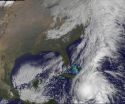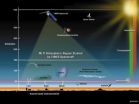(Press-News.org) Most mutations in the genes of the Salmonella bacterium have a surprisingly small negative impact on bacterial fitness. And this is the case regardless whether they lead to changes in the bacterial proteins or not. This is shown by Uppsala University scientists in an article being published today in the prestigious journal Science.
The researchers have examined the impact of mutations on the rate of growth of the Salmonella bacterium and show that most mutations have generally very small effects. Moreover the negative effects are of the similar magnitude for changes that lead to substitution of amino acids in proteins (so-called non-synonymous mutations) as for mutations that do not change the protein sequence (so-called synonymous mutations).
"The findings open an entirely new chapter for experimental studies of mutations and show that we need to change our view of how mutations lead to negative effects," says Professor Dan Andersson, lead author of the study.
A central question in evolutionary biology, medical genetics, species-conservation biology, and animal breeding is how and why mutations affect an organism's capacity to survive. Usually these questions are studied in DNA sequence analyses from which conclusions have been drawn about what mutations are most common and have become established in the DNA of the organism.
The Uppsala scientists have used another -- experimental -- method whereby they can use various genetic tricks to introduce random individual mutations into any chosen gene, a method that has previously been used primarily in viruses. Two genes that code for proteins that are included in ribosomes were mutated, and using extremely sensitive growth measurements, doctoral candidate Peter Lind showed that most mutations reduced the rate of growth of bacteria by only 0.500 percent. No mutations completely disabled the function of the proteins, and very few had no impact at all.
Even more surprising was the fact that mutations that do not change the protein sequence had negative effects similar to those of mutations that led to substitution of amino acids. A possible explanation is that most mutations may have their negative effect by altering mRNA structure, not proteins, as is commonly assumed.
### END
Unexpectedly small effects of mutations in bacteria bring new perspectives
2010-11-06
ELSE PRESS RELEASES FROM THIS DATE:
Should our biggest climate change fear be fear itself?
2010-11-06
From apocalyptic forecasting to estimates of mass extinctions, climate change is a topic which is filled with fearful predictions for the future. In his latest research, published in WIREs Climate Change, historian Matthias Dörries examines the cultural significance of fear and how it became a central presence in current debates over climate change.
Climatic change, as represented by the media, often prompts headlines predicting disastrous events, frequently adopting fear laden language including analogies with war and warnings of the imminence or irreversibility of ...
Looking older than your age may not be a sign of poor health: Study
2010-11-06
Toronto, Ontario, November 5, 2010 – Even though most adults want to avoid looking older than their actual age, research led by St. Michael's Hospital shows that looking older does not necessarily point to poor health. The study found that a person needed to look at least 10 years older than their actual age before assumptions about their health could be made.
"Few people are aware that when physicians describe their patients to other physicians, they often include an assessment of whether the patient looks older than his or her actual age," says Dr. Stephen Hwang, a ...
New statistical model moves human evolution back 3 million years
2010-11-06
Evolutionary divergence of humans from chimpanzees likely occurred some 8 million years ago rather than the 5 million year estimate widely accepted by scientists, a new statistical model suggests.
The revised estimate of when the human species parted ways from its closest primate relatives should enable scientists to better interpret the history of human evolution, said Robert D. Martin, curator of biological anthropology at the Field Museum, and a co-author of the new study appearing in the journal Systematic Biology. Here is a link to the article: http://sysbio.oxfordjournals.org/content/early/2010/11/04/sysbio.syq054.full.html?ijkey=CaQif1LgTAd7xOD&keytype=ref
Working ...
'Prima donna' protein doesn't work well in pairs
2010-11-06
HOUSTON -- (Nov. 5, 2010) -- A new study by Rice University bioengineers finds that the workhorse proteins that move cargo inside living cells behave like prima donnas. The protein, called kinesin, is a two-legged molecular machine. Rice's scientists invented tools that could measure the pulling power of kinesin both singly and in pairs, and they report this week in Biophysical Journal that kinesins don't work well together -- in part because they are so effective on their own.
"Researchers have been investigating the mechanical properties of individual motor proteins ...
Story tips from the Department of Energy's Oak Ridge National Laboratory, November 2010
2010-11-06
VEHICLES -- Charge on the fly . . .
A prototype charging system for electric and hybrid vehicles is helping demonstrate a technology that could one day play a key role in the electrification of America's highways. The bench-scale prototype developed at Oak Ridge National Laboratory is allowing researchers to quantify the power transfer parameters necessary to wirelessly charge stationary and moving vehicles. "Our laboratory tests have been successful in transmitting greater than 4 kilowatts," said Laura Marlino of the Energy and Transportation Science Division. "This ...
GOES-13 Satellite sees Hurricane Tomas lashing Haiti and eastern Cuba today
2010-11-06
Tomas strengthened to hurricane status and is currently lashing Hispaniola and eastern Cuba today and the GOES-13 satellite provided a visible image of its extensive cloud cover.
The Geostationary Operational Environmental Satellite known as GOES-13 captured a visible image of Hurricane Tomas on Nov. 5 at 1331 UTC (9:31 a.m. EDT) centered over the southwestern tip of Haiti. In the image the clouds to the north of Tomas are associated with a cold front off the eastern U.S. coast. GOES satellites are operated by NOAA. The NASA GOES Project at NASA's Goddard Space Flight ...
NASA extends TIMED mission for fourth time
2010-11-06
Nine years after beginning its unprecedented look at the gateway between Earth's environment and space, not to mention collecting more data on the upper atmosphere than any other satellite, NASA's Thermosphere Ionosphere Mesosphere Energetics and Dynamics (TIMED) mission has been extended again.
Before the launch of TIMED, the mesosphere and lower thermosphere/ionosphere -- which help protect us from harmful solar radiation -- had been one of the least explored and understood regions of our environment.
"The middle part of the atmosphere was the part we kind of ignored," ...
Understanding diabetes at the molecular level
2010-11-06
United States and Japanese researchers have identified a key step in metabolic pathways linked to diabetes and cancer. The study on activation of the protein complex TORC 2 was published online in the journal Current Biology Oct. 28.
TORC 2 activates a protein called Akt, which plays a crucial role in how cells respond to insulin, said Kazuo Shiozaki, professor of microbiology in the College of Biological Sciences at UC Davis and senior author on the paper.
Normally, insulin triggers fat and muscle cells to take up sugar from the blood. Patients with type II diabetes ...
Johns Hopkins researchers reshape basic understanding of cell division
2010-11-06
By tracking the flow of information in a cell preparing to split, Johns Hopkins scientists have identified a protein mechanism that coordinates and regulates the dynamics of shape change necessary for division of a single cell into two daughter cells.
The protein, called 14-3-3, sits at an intersection where it integrates converging signals from within the cell and cues cell shape change and, ultimately, the splitting that allows for normal and abnormal cell growth, such as in tumors.
In a report published Nov. 9 in Current Biology, the Hopkins team links 14-3-3 directly ...
Specialization builds trust among Web users
2010-11-06
If you name it, they will use it, according to a team of international researchers who investigated how people perceive the trustworthiness of online technology. In an experiment, participants said they trusted websites, recommendation-providing software and even computers labeled to perform specific functions more than the same Internet tools with general designations, according to S. Shyam Sundar, Distinguished Professor of Communications, Penn State.
"In general, the attribution of specialization can increase the credibility of a product or any kind of object," Sundar ...


